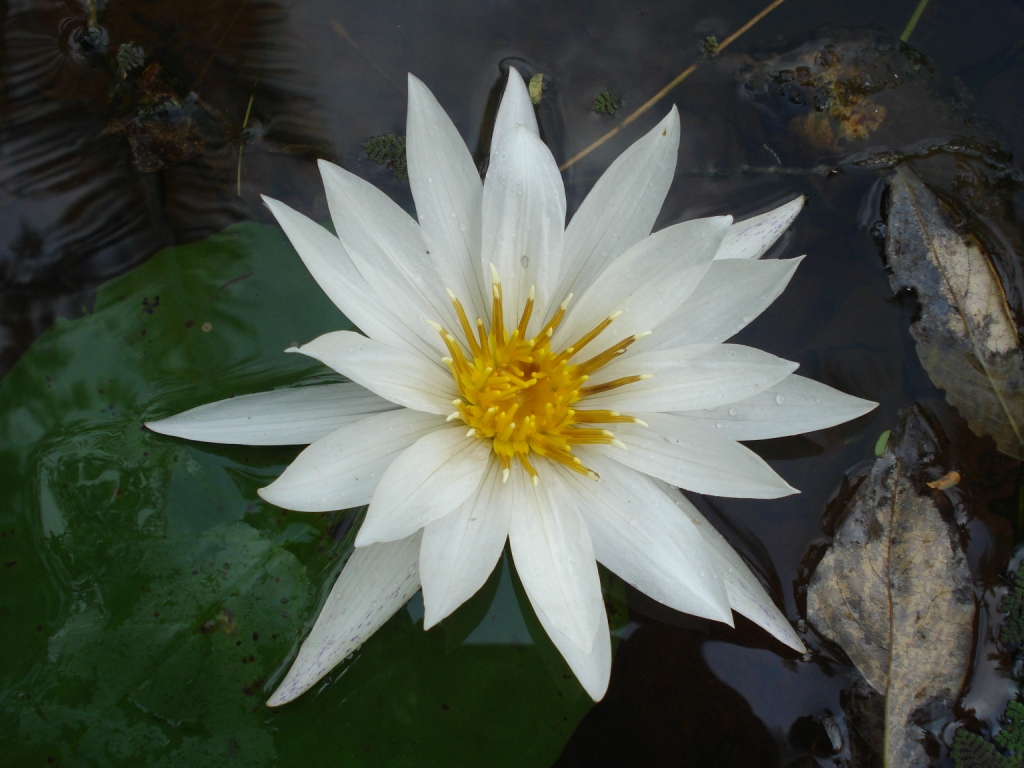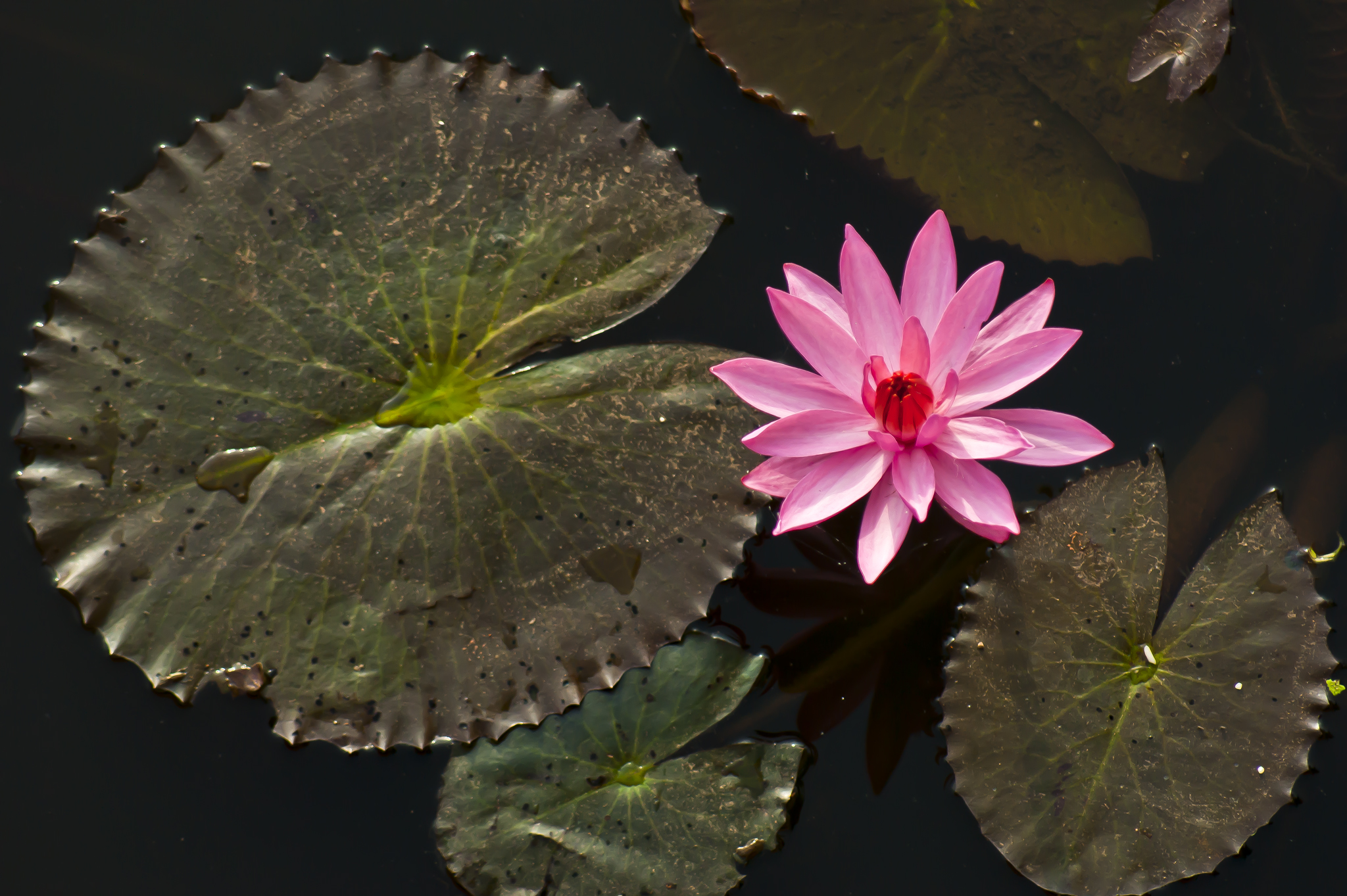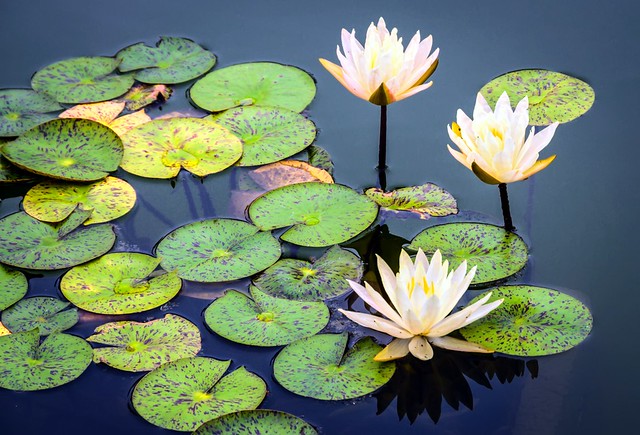Nymphaeaceae
White water lily (Nymphaea alba)
The water lilies ( Nymphaeaceae ) are a family in the order of the lily -like ( Nymphaeales ). With 58 ( to 75) species in six genera the Nymphaeaceae are a small family of flowering plants. It is present only in fresh water world outside the polar regions.
- 2.1 subfamilies with genera
- 4.1 Notes and references
Description and ecology
Appearance and leaves
Most species of the family Nymphaeaceae are perennial, rarely annual, herbaceous plants. They are all in the seabed anchored with adventitious roots of water plants with creeping or erect, branched or unbranched rhizomes, which may be thickened bulbous than Überdauerungsorganen that form in some species foothills ( stolons ). The rhizodermis is divided into long and short cells. A secondary growth does not occur. You have scattered vascular bundles without cambia and without tracheae. The Siebröhrenplastiden do not Proteinkristalloide. In plants, a milky juice is available. There are very significant air chambers present in the vegetative parts of plants.
As leaves underwater and floating leaves may be present. The alternate and spirally arranged leaves are simple and stalked. The simple leaf blade is often heart-shaped to circular, peltate ( Peltatum ) and netzadrig. The leaf margin is smooth or spiny- toothed. There may be stipules.
Flowers
The flowers are single, page constantly often long flower stems on or above the water level, rarely flourish under the water level. The large, hermaphrodite, more or less radial symmetry flowers often fragrant. The petals are arranged partially schraubig (acyclic). The bloom can continuously into nectar and leaves in these stamens. The perianth usually consists of two circles. The five or 20 to 50 free, usually green sepals may be kronblattähnlich ( Nuphar ). The five ( Nuphar ) or 15 to 50 petals are yellow or white through pink to purple and blue; rarely they are missing. There are 40 to 80 developing centripetally, spirally arranged, free stamens present, it can be 11 to 20 staminodes ( in Nuphar are nectar forming scales). The stamens are wide and slim. The anthers are tetrasporangiat and a connective appendages may be present. The five to 35 above permanent to semi- permanent under carpels ( carpels ) are partially or completely fused. There are tens to hundreds of ovules per carpel available. The scars sit right, so usually without stamp, in a circle on a discus.
The flowers are open depending on the type during the day or night. Pollination is by insects ( mostly beetles, entomophily ).
Fruit and seeds
The often surrounded by the bloom cladding, fleshy fruits are berry -like and contain several to many seeds. The often embedded in the fleshy bottom fruits open usually by swelling of the inner mucus. The seeds have a small endosperm and usually an aril. The embryo is relatively small. The seeds of many species can swim through air pockets in the aril and the seed wall. It also forms two fleshy cotyledons ( cotyledons ).
As ingredients ellagic acid and gallic acid are present.
System
The Nymphaeaceae family was in 1805 by Salisb. Ann. Bot ( König & Sims ), 2, June 1805, published in S. 70. The Barclayaceae HLLi, Euryalaceae J.Agardh and Nupharaceae A.Kerner were formerly independent families are assigned to the Nymphaeaceae today their genres.
Among families with genera
In the family Nymphaeaceae there are two subfamilies with six genera and 58 to 75 species:
- Nupharoideae Ito ( Syn: Nupharaceae A.Kerner ): it contains only one genus with eight to eleven species: Water lilies ( Nuphar Sm, Syn: Nymphozanthus Rich. ): It contains two sections with eight to eleven species. It is distributed in the northern hemisphere in the Holarctic, as well as in directly adjacent subtropical areas.
- Barclaya Wall. ( Syn: Hydrostemma Wall. ): The approximately four species are common in Southeast Asia.
- Euryale Salisb. Contains only one type: Spiked water lily ( Euryale ferox Salisb. ): She comes from Kashmir to Assam and China before.
Use
Some species, especially hybrids, are used as ornamental plants in parks and gardens. Few species are used as aquarium plants. The flowers of Nymphaea odorata are popular because of the especially in the morning strongly scented flowers.
In some species, the underground plant parts are eaten raw or cooked or there is strength gained from it ( Nuphar advena, Nuphar japonicum, Nuphar lutea Nuphar polysepala, Nuphar pumila, Nymphaea alba, Nymphaea odorata Nymphaea tetragona Nymphaea tuberosa ). In some species, the seeds are used raw, cooked or roasted processed into flour as food ( Nuphar advena, Nuphar lutea Nuphar polysepala, Nuphar pumila, Nymphaea alba, Nymphaea odorata Nymphaea tetragona Nymphaea tuberosa ). The leaves of Nuphar lutea Nuphar pumila and Nymphaea odorata be cooked or eaten raw in some species. From the flowers of Nuphar lutea Nuphar pumila and a soft drink is produced. Roasted seeds of Nymphaea alba serve as a coffee substitute. The flower buds of Nymphaea odorata be eaten cooked as a vegetable or pickled.
The medicinal properties of some species was investigated.
Swell
- The Nymphaeaceae in APWebsite family. (English )
- The Nymphaeaceae at DELTA by L. Watson & MJ Dallwitz family. ( Description section )
- John H. Wiersema & C. Barre Hellquist: Nymphaeaceae - text the same online as printed work, In: Flora of North America Editorial Committee ( eds.): Flora of North America North of Mexico, Volume 3 - Magnoliidae and Hamamelidae, Oxford University Press, New York and Oxford, 1997. ISBN 0-19-511246-6
- Dezhi Fu, John H. Wiersema & Donald Padgett: Nymphaeaceae, pp. 115 - text the same online as printed work, in: Wu Zhengyi, Peter H. Raven & Deyuan Hong (eds.): Flora of China, Volume 6 - Caryophyllaceae through Lardizabalaceae. Science Press and Missouri Botanical Garden Press, Beijing and St. Louis, 2001. ISBN 1-930723-05-9
- Leslie Watson, 2008: Nymphaeaceae in the Western Australian flora.
- Bernard Verdcourt: Nymphaeaceae, Flora of Tropical East Africa, Royal botanic gardens Kew, 1989, 12 pages.










